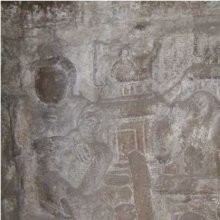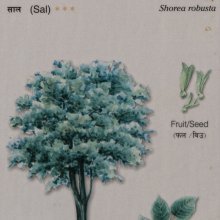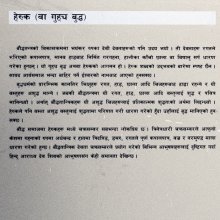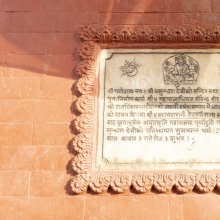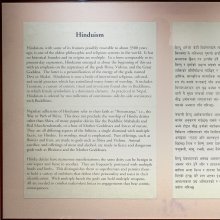Cala, Cāla, Calā: 40 definitions
Introduction:
Cala means something in Buddhism, Pali, Hinduism, Sanskrit, Jainism, Prakrit, Marathi, Hindi, biology, Tamil. If you want to know the exact meaning, history, etymology or English translation of this term then check out the descriptions on this page. Add your comment or reference to a book if you want to contribute to this summary article.
Alternative spellings of this word include Chala.
Images (photo gallery)
In Hinduism
Purana and Itihasa (epic history)
Source: archive.org: Puranic EncyclopediaCalā (चला).—Lakṣmīdevī. The following story is told in the Devī-bhāgavata as to how this name came to be applied to the devī. Once Revanta the very handsome son of Sūryadeva came to Vaikuṇṭha riding Uccaiḥśravas, Indra’s horse. Devī, who was at that time with Viṣṇu gazed for a few minutes in wonder at the horse. She did not, therefore, attend to Viṣṇu’s talk. Angered at this Viṣṇu told the devī: "Since your eyes find enjoyment on unnecessary things and move about among such objects, you shall be called from today onwards Ramā and Calā. Also you will be born as a mare on earth. Accordingly Mahālakṣmī was born as a mare on the banks of river Sarasvatī, and regained her old form only after delivering a son by Viṣṇu. That son was Ekavīra, founder of the Hehaya kingdom. (Devī Bhāgavata, Skandha 6).
Source: Cologne Digital Sanskrit Dictionaries: The Purana Index1) Cala (चल).—A son of Madīrā.*
- * Vāyu-purāṇa 96. 169.
2) Calā (चला).—A name of Lakṣmi.*
- * Viṣṇu-purāṇa I. 7. 28.

The Purana (पुराण, purāṇas) refers to Sanskrit literature preserving ancient India’s vast cultural history, including historical legends, religious ceremonies, various arts and sciences. The eighteen mahapuranas total over 400,000 shlokas (metrical couplets) and date to at least several centuries BCE.
Yoga (school of philosophy)
Source: Wisdom Library: YogaCāla is one of the eighty-four Siddhas associated with eighty-four Yogic postures (āsanas), according to popular tradition in Jodhpur, Rājasthān. These posture-performing Siddhas are drawn from illustrative sources known as the Nava-nātha-caurāsī-siddha from Vȧrāṇasī and the Nava-nātha-caruāsī-siddha-bālāsundarī-yogamāyā from Puṇe. They bear some similarity between the eighty-four Siddhas painted on the walls of the sanctum of the temple in Mahāmandir.
The names of these Siddhas (e.g., Cāla) to 19th-century inscription on a painting from Jodhpur, which is labelled as “Maharaja Mansing and eighty-four Yogis”. The association of Siddhas with yogis reveals the tradition of seeing Matsyendra and his disciple Gorakṣa as the founders of haṭhayoga.
Source: Brill: Śaivism and the Tantric Traditions (yoga)Cala (चल) refers to the “movement” (of bindu), according to the Amṛtasiddhi, a 12th-century text belonging to the Haṭhayoga textual tradition.—Accordingly, “It is taught that when the breath moves bindu moves (cala); the mind of he whose bindu is moving is restless”.
Source: ORA: Amanaska (king of all yogas): A Critical Edition and Annotated Translation by Jason BirchCala (चल) refers to “movement” (as opposed to Acala—“that which has no movement”), according to the Amanaska Yoga treatise which deals absorption, yogic powers and liberation.—The Amanaska referred to (or qualified) Samādhi with several terms, which are all negative; [e.g., it has no movement (acala);] [...] The fact that such terminology is found in the Amanaska indicates that descriptions of Śiva and the void-like meditative states in Mantramargic Śaivism, were the basis of the descriptions of Samādhi and Paratattva (the highest reality) in this treatise. The Amanaska Yoga was consistent with the Pātañjala Yogaśāstra’s definition of Yoga, yet it described Samādhi in terms different to those of Pātañjalayoga; such as Acala—“that which has no movement”.

Yoga is originally considered a branch of Hindu philosophy (astika), but both ancient and modern Yoga combine the physical, mental and spiritual. Yoga teaches various physical techniques also known as āsanas (postures), used for various purposes (eg., meditation, contemplation, relaxation).
Jyotisha (astronomy and astrology)
Source: Wisdom Library: Brihat Samhita by VarahamihiraCala (चल) or Calaketu refers to a particular type of Ketus (i.e., luminous bodies such as comets and meteors), according to the Bṛhatsaṃhitā (chapter 11), an encyclopedic Sanskrit work written by Varāhamihira mainly focusing on the science of ancient Indian astronomy astronomy (Jyotiṣa).— Accordingly, “Cala Ketu is a comet which appears in the west with a tail an inch in length pointing to the south; as it proceeds more and more towards the north, it increases in length. After touching the Pole star or the constellation of Abhijit, it turns back and after travelling one half of the sky disappears in the south. When this Ketu appears, the country between Prayāga (Allahabad) and Avantī, the forests near Puṣkara, the north, the country of Devikā and Madhyadeśa will perish. The other countries will also suffer in several places from disease and from famine; the effects described will last for 10 months according to some and for 18 months according to others”.
Source: academia.edu: Tithikarmaguṇa in GārgīyajyotiṣaCalā (चला) or Calatithi is the name of the third of fifteen tithis (cycle of time) according to the Śārdūlakarṇāvadāna while the Gārgīyajyotiṣa considers Balā or Balatithi as the third. The associated deity for Calā or Balā according to the Bṛhatsaṃhitā is Hari. A tithi was defined as one thirtieth of a synodic month (c. 29.5 days), resulting in an average tithi being slightly less than a day.
Accordingly, “(15) The third tithi is said to be Balā. One may have an army on this tithi. One should perform the taming of tamable cows, horses, elephant and servants. (16) One should perform all kinds of rites and sow seeds. Or, one should engage in the act of strength. One should know Viṣṇu as the deity”.

Jyotisha (ज्योतिष, jyotiṣa or jyotish) refers to ‘astronomy’ or “Vedic astrology” and represents the fifth of the six Vedangas (additional sciences to be studied along with the Vedas). Jyotisha concerns itself with the study and prediction of the movements of celestial bodies, in order to calculate the auspicious time for rituals and ceremonies.
Chandas (prosody, study of Sanskrit metres)
Source: Shodhganga: a concise history of Sanskrit Chanda literatureCala (चल) refers to one of the 23 types of dohā metres (a part of mātrā type) described in the 1st chapter of the Vṛttamauktika by Candraśekhara (17th century): author of many metrical compositions and the son of Lakṣmīnātha Bhaṭṭa and Lopāmudrā.

Chandas (छन्दस्) refers to Sanskrit prosody and represents one of the six Vedangas (auxiliary disciplines belonging to the study of the Vedas). The science of prosody (chandas-shastra) focusses on the study of the poetic meters such as the commonly known twenty-six metres mentioned by Pingalas.
Shilpashastra (iconography)
Source: Shodhganga: The significance of the mūla-beras (śilpa)Cala (चल, “movable”) refers to one of the major divisions of Hindu images, as defined in the texts dealing with śilpa (arts and crafs), known as śilpaśāstras.—The Hindu images are divided into three classes–chala (movable), achala (immovable), and chalāchala (movable-immovable). The moveable (cala) images are easily portable and are made of loha (metal). The images that come under this category are the kautukaberas, meant for arcana (dedication); the utsavaberas are meant for festive occasions in processions; the baliberas are meant for the purpose of offering sacrifice to the parivāras; and snāpanaberas are used for holy bathing. In short, the bhoga mūrti or utsava-vigraha that are carried in processions are the best examples for cala.

Shilpashastra (शिल्पशास्त्र, śilpaśāstra) represents the ancient Indian science (shastra) of creative arts (shilpa) such as sculpture, iconography and painting. Closely related to Vastushastra (architecture), they often share the same literature.
Ayurveda (science of life)
Source: gurumukhi.ru: Ayurveda glossary of termsCala (चल):—To move
Source: National Mission for Manuscripts: Traditional Medicine System in IndiaCala (चल, “mobile”) and Sthira (“static”) refers to one of the ten counterpart-couples of the twenty Śārīraguṇa (or Gurvādiguṇa), which refers to the “twenty qualities of the body”—where guṇa (property) represents one of the six divisions of dravya (drugs).—Śārīraka-guṇas are twenty in number. There are ten guṇas with their opposite guṇas. [...] Sthira (“static”) has the predominant bhūta (element) of earth and the associated actions of “stabilising/dhāraṇa”; while Cala (“mobile”) has the predominant bhūta (element) of air and is associated with the action “stimulating/preraṇa”.

Āyurveda (आयुर्वेद, ayurveda) is a branch of Indian science dealing with medicine, herbalism, taxology, anatomy, surgery, alchemy and related topics. Traditional practice of Āyurveda in ancient India dates back to at least the first millenium BC. Literature is commonly written in Sanskrit using various poetic metres.
Vaishnavism (Vaishava dharma)
Source: Brill: Śaivism and the Tantric Traditions (vaishnavism)Cala (चल) or Calacitta refers to the “fluctuations (of the mind)”, according to the Vedānta Deśika’s Yatirājasaptati.—This view of Rāmānuja’s central role in the establishment of a new, Viśiṣṭādvaita Vedānta is the second central motif in the poem. Thus, even while we also have verses in the poem that, like in the Irāmāṉuja Nūṟṟantāti, echo the sentiments of taking refuge at the feet of Rāmānuja, such as verses Verse 18, where those who take refuge at the feet of Yatipati become free of sin or Verse 20, where the feet are a refuge compared to medicine that stills the fluctuations of the mind (cala-citta-vṛtti), it becomes clear that the framework of the poem does not allow for a predominant focus on the analogy between Rāmānuja and Kṛṣṇa nor that his feet themselves are the predominant upāya for mokṣa.

Vaishnava (वैष्णव, vaiṣṇava) or vaishnavism (vaiṣṇavism) represents a tradition of Hinduism worshipping Vishnu as the supreme Lord. Similar to the Shaktism and Shaivism traditions, Vaishnavism also developed as an individual movement, famous for its exposition of the dashavatara (‘ten avatars of Vishnu’).
Kavya (poetry)
Source: Brill: Śaivism and the Tantric Traditions (kavya)Cala (चल) refers to the “shaking (of a tree in the wind)”, according to Kālidāsa’s Raghuvaṃśa verse 8.90-91.—Accordingly: “'[...] When we are taught that our own body and soul unite and then separate, tell me which wise person should be tormented by separation from the external objects of the senses? Best of the self-controlled! You ought not to become subject to grief like common people. What would be the difference between a tree and a mountain if both shook (cala) in the wind?”.

Kavya (काव्य, kavya) refers to Sanskrit poetry, a popular ancient Indian tradition of literature. There have been many Sanskrit poets over the ages, hailing from ancient India and beyond. This topic includes mahakavya, or ‘epic poetry’ and natya, or ‘dramatic poetry’.
Sports, Arts and Entertainment (wordly enjoyments)
Source: archive.org: Syainika Sastra of Rudradeva with English Translation (art)Cala (चल) refers to “moving objects” (encountered while hunting), according to the Śyainika-śāstra: a Sanskrit treatise dealing with the divisions and benefits of Hunting and Hawking, written by Rājā Rudradeva (or Candradeva) in possibly the 13th century.—Accordingly, “Hunting on horseback (āśvina) represents one of the eight subdivisions of Hunting (mṛgayā). [...] The practice of hunting on horseback reduces fat, lightens the body, enhances strength and ambition, hardens the muscles, kindles appetite, produces a capacity for enduring [...], generates a skill in aiming at moving objects (cala-lakṣyā) [calalakṣyādinaipuṇyam] [...],. These and many such excellences are acquired by it for one’s own benefit. [...]”.

This section covers the skills and profiencies of the Kalas (“performing arts”) and Shastras (“sciences”) involving ancient Indian traditions of sports, games, arts, entertainment, love-making and other means of wordly enjoyments. Traditionally these topics were dealt with in Sanskrit treatises explaing the philosophy and the justification of enjoying the pleasures of the senses.
General definition (in Hinduism)
Source: archive.org: Indian Historical Quarterly Vol. 7Cala (चल) is the name of a country classified as Hādi (a type of Tantrik division), according to the 13th century Sammoha-tantra (fol. 7).—There are ample evidences to prove that the zone of heterodox Tantras went far beyond the natural limits of India. [...] The zones in the Sammoha-tantra [viz., Cala] are here fixed according to two different Tantrik modes, known as Kādi and Hādi.
In Buddhism
Theravada (major branch of Buddhism)
Source: Pali Kanon: Pali Proper Names1. Cala Theri - Daughter of Surupasari and, therefore, younger sister of Sariputta. She had two sisters, Upacala and Sisupacala, and all three left the world and joined the Order on hearing of Sariputtas renunciation. In due course they attained arahantship (ThigA.162ff; DhA.ii.188). It is said (Thig.182-8; cp. S.i.132) that one day, when Cala was taking her siesta in the Andhavana, Mara visited her, asking her various questions and trying to tempt her. Her son was Cala.
2. Cala - Chief of the lay women supporters of Sumangala Buddha. Bu.v.28.
3. Cala - One of the two chief women disciples of Phussa Buddha. Bu.xix.20; J.i.41.
4. A Sinhalese chieftain, who once joined the Colas against Vijayabahu I., (Cv.lviii.16) but who, later (Cv.vs.55; see Cv.Trs.i.207, n.3), evidently returned to him and fought bravely on his side.
5. Cala Thera: Son of Cala and nephew of Sariputta. He was ordained by Khadiravaniya Revata (Thag.vs.42; ThigA.i.110). He is mentioned as living at the Kutagarasala, which place he left when the Licchavis caused disturbance by their visits to the Buddha (A.v.133). In this context he is spoken of as a very eminent Elder and was, therefore, evidently an arahant.
Theravāda is a major branch of Buddhism having the the Pali canon (tipitaka) as their canonical literature, which includes the vinaya-pitaka (monastic rules), the sutta-pitaka (Buddhist sermons) and the abhidhamma-pitaka (philosophy and psychology).
Tibetan Buddhism (Vajrayana or tantric Buddhism)
Source: Wisdom Library: Tibetan BuddhismCala (चल) is the name of a deity summoned by the Yamāntaka-mantra and mentioned as attending the teachings in the 6th century Mañjuśrīmūlakalpa: one of the largest Kriyā Tantras devoted to Mañjuśrī (the Bodhisattva of wisdom) representing an encyclopedia of knowledge primarily concerned with ritualistic elements in Buddhism. The teachings in this text originate from Mañjuśrī and were taught to and by Buddha Śākyamuni in the presence of a large audience (including Cala).
Source: academia.edu: A Critical Study of the Vajraḍākamahātantrarāja (II)Cala (चल) is the name of a Vākchomā (‘verbal secrect sign’) which has its meaning defined as ‘vāyu’ according to chapter 8 of the 9th-century Vajraḍākamahātantrarāja, a scripture belonging to the Buddhist Cakrasaṃvara (or Saṃvara) scriptural cycle. These Vākchomās (viz., cala) are meant for verbal communication and can be regarded as popular signs, since they can be found in the three biggest works of the Cakrasaṃvara literature.

Tibetan Buddhism includes schools such as Nyingma, Kadampa, Kagyu and Gelug. Their primary canon of literature is divided in two broad categories: The Kangyur, which consists of Buddha’s words, and the Tengyur, which includes commentaries from various sources. Esotericism and tantra techniques (vajrayāna) are collected indepently.
In Jainism
General definition (in Jainism)
Source: archive.org: Een Kritische Studie Van Svayambhūdeva’s PaümacariuCala (चल) participated in the war between Rāma and Rāvaṇa, on the side of the latter, as mentioned in Svayambhūdeva’s Paumacariu (Padmacarita, Paumacariya or Rāmāyaṇapurāṇa) chapter 57ff. Svayambhū or Svayambhūdeva (8th or 9th century) was a Jain householder who probably lived in Karnataka. His work recounts the popular Rāma story as known from the older work Rāmāyaṇa (written by Vālmīki). Various chapters [mentioning Cala] are dedicated to the humongous battle whose armies (known as akṣauhiṇīs) consisted of millions of soldiers, horses and elephants, etc.
Source: SOAS Research Online: Prekṣā meditation: History and MethodsCala (चल) refers to “movable”; as opposed to Acala—“immovable” which refers to one of the 46 qualities of the soul to be meditated on in the “Practice of Meditation on Liberated Souls (Siddhas)”, according to Jain texts like Ācārāṅga (5.6.123-140), Ṣaṭkhaṇḍāgama (13.5.4.31) and Samayasāra (1.49).—The pure soul can be recognised by meditation on its true nature, represented by the liberated souls of the Siddhas. [...] The qualities of the soul to be meditated on as truly mine are: [e.g., My soul is immovable (a-cala)] [...] The meditation on such extended fourty-five qualities of the pure soul presents the niśacaya-naya, which is aligned with Kundakunda’s approach.

Jainism is an Indian religion of Dharma whose doctrine revolves around harmlessness (ahimsa) towards every living being. The two major branches (Digambara and Svetambara) of Jainism stimulate self-control (or, shramana, ‘self-reliance’) and spiritual development through a path of peace for the soul to progess to the ultimate goal.
Biology (plants and animals)
Source: Google Books: CRC World Dictionary (Regional names)Cala in India is the name of a plant defined with Buchanania latifolia in various botanical sources. This page contains potential references in Ayurveda, modern medicine, and other folk traditions or local practices.
Example references for further research on medicinal uses or toxicity (see latin names for full list):
· Hortus Bengalensis, or ‘a Catalogue of the Plants Growing in the Hounourable East India Company's Botanical Garden at Calcutta’ (1814)
· Journal für die Botanik (1800)
· Taxon (1979)
· Flora Indica (1832)
If you are looking for specific details regarding Cala, for example diet and recipes, side effects, extract dosage, pregnancy safety, health benefits, chemical composition, have a look at these references.

This sections includes definitions from the five kingdoms of living things: Animals, Plants, Fungi, Protists and Monera. It will include both the official binomial nomenclature (scientific names usually in Latin) as well as regional spellings and variants.
Languages of India and abroad
Pali-English dictionary
Source: BuddhaSasana: Concise Pali-English Dictionarycala : (adj.) moving; quivering; unsteady. || cāla (m.) a shock; a sudden agitation.
Source: Sutta: The Pali Text Society's Pali-English DictionaryCāla, (From calati) shaking, a shock, only in bhūmi° earthquake. (Page 265)
— or —
Cala, (adj.) (see calati) moving, quivering; unsteady, fickle, transient S. IV, 68 (dhammā calā c’eva vyayā ca aniccā, etc.); J. II, 299; III, 381; V, 345; Miln. 93, 418; Sdhp. 430, 494. —acala steadfast, immovable S. I, 232; J. I, 71 (ṭṭhāna); Vv 514 (°ṭṭhāna=Ep. of Nibbāna); acalaṃ sukhaṃ (=Nibbāna) Th. 2, 350; cp. niccala motionless DhA. III, 38.

Pali is the language of the Tipiṭaka, which is the sacred canon of Theravāda Buddhism and contains much of the Buddha’s speech. Closeley related to Sanskrit, both languages are used interchangeably between religions.
Marathi-English dictionary
Source: DDSA: The Molesworth Marathi and English Dictionarycala (चल).—a (S) Movable or in motion; not fixed or stationary. 2 fig. Transitory, fugitive, passing away.
--- OR ---
caḷa (चळ).—m (calana S) Slipperiness or slippiness. v paḍa. Ex. jāgēlā tara caḷa paḍatōca parantu dravyālā paḍatō. 2 Deviation or departure (from one's word, or from some law, rule, or prescribed course). Ex. pari vacanāsi caḷa navhē mājhyā ||. Also mantradēvatā sādhya karaṇyāviṣayīṃ jē niyama sāṅgitalē āhēta tyānta yatkiñcit caḷa jhālā tara anartha hōtō. 3 Idiocy or fatuity. v lāga. In this sense some compounds are in use; kāma-dravya-dhana-madya-śāstra-strī-caḷa. Mem. In the above three senses the ca is both tsh and ts. 4 m f An obstinate whining or pining after (as of children). v ghē. 5 f The state of inability to cease from crying to which children by obstinate crying reduce themselves. 6 m Wild or eager desire after; vehement craving or itching; mad impatience. v ghē, bhara, yē, lāga.
--- OR ---
cāla (चाल).—f (cālaṇēṃ) Moving, going, walking, journeying. Custom or fashion; practices or habits; way, manner, method. 3 Gait, air, step, pace, manner of walking. 4 A pace of the horse. These are kukaracāla, kōṅkaracāla, khudakīcāla, cavaḍacāla, caukacāla, ṭākaṇacāla, turūka or turkīcāla, duḍakīcāla, dhāṃvarīcāla, bājīcāla, bharadhāṃvacāla, hudaruka or huda- rukacāla. 5 Currency or circulation (of a coin). 6 Managing or making shift with. Ex. sōvaḷēṃ dusarēṃ kāṃhīṃ nāhīṃ mhaṇūna dhābaḷīvara cāla karatō. 7 Power, prevalence, influence, authority. Ex. darabārānta tyācī cāla hōtī tēthaparyanta tyācēṃ vāṅkaḍēṃ kōṇhācyānēṃhī jhālēṃ nāhīṃ. 8 Kind, sort, variety (of metre &c.): also a tune (in music). 9 Assailing or falling upon. v kara. 10 The juttings out and retirings of the end of a wall, left to admit of the junction of another wall: also the indented edge (of a thatch &c.) left to admit of addition. 11 The chip driven in betwixt the male and the female screws of a sugarmill. cāla karaṇēṃ To fall upon, move upon, attack. 2 or cālīvara ghēṇēṃ To manage or shift with; to get on with, or make to do. cālīsa lāgaṇēṃ To begin to proceed; to enter upon its course--some business or action. cālīsa lāvaṇēṃ To set a going.
--- OR ---
cāla (चाल).—a Current--money. In comp. with a designating noun, as guṇēcāla, cāndavaḍacāla, samaśērī- cāla, nāśikacāla.
--- OR ---
cāḷa (चाळ).—a (cāḷā) Wanton, coquettish, riggish, flirty--a female.
--- OR ---
cāḷa (चाळ).—f A long and narrow building; as for stabling, shops &c.: also a row, line, or series (of shops or uniform houses). 2 m A jingling ornament on the ankles of dancers. 3 A hiss or whistle made by the mouth, in imitation of the sound of the ornament. 4 The threads of a web left unwoven where divisions of it are to be made. 5 A kind of ringworm. 6 f Trick, freak of fancy, whimsey. Ex. pōrācī rōja navī navī cāḷa. 7 m A quantity of the seeds of sāgaragōṭī as tossed up by the hand. In a play of children. 8 m C A pit made in a khārēpāṭa or salt marsh, to receive the fish brought by the flowing tide.
--- OR ---
cāḷa (चाळ).—m P (cāḷaṇēṃ To sift &c.) Searching, seeking, looking for, quest. 2 Turning and shifting; turning and tossing about; whether turning over and relaying orderly, or tumbling over as in rummaging. Hence fig. turning schemes and tentative measures; adopting various devices, expedients, and shifts. v kara.
--- OR ---
cāḷā (चाळा).—m Tricks, pranks, frolics, mischievous practices. 2 A liking or taking to; a fondness for. v lāga. Ex. tyālā gāṇēṃ aikāvayācā cāḷā lāgalā āhē. 3 A trick, a way, a silly habit: also a habit or way of good or indifferent character. Ex. vācēsī śivanāmācā cāḷā ||. 4 A form of mortising, or of intersertion or interlocking of bodies or of parts: viz. that of the dove-tail; of the fingers intertwined with the ends downwards; of the parts of hinges; of the unwoven threads of cloth where divisions are to be made; an articulation or a joint; as hātācā-maṇagaṭācā-mānēcā-khavāṭyācā-guḍaghyācā- cāḷā. 5 The name of a class of goblins or fiends. 6 In the loom. The cord connecting the pāvaḍā and the pāvasarā. 7 A spot in a web or texture left unwoven, or become open by the slipping aside of the threads. 8 That member of the loom otherwise called ōvī or vahī, where see it described.
Source: DDSA: The Aryabhusan school dictionary, Marathi-Englishcala (चल).—a Movable or in motion; not fixed or stationary. Transitory.
--- OR ---
caḷa (चळ).—m Slipperiness or slippiness. Devi- ation or departure. Idiocy or fatuity. Wild or eager desire after.
--- OR ---
cāla (चाल).—f Moving. Custom.Gait. Currency Kind. Influence. Assailing. a Current. cāla karaṇēṃ Fall upon, attack; get on with. cālavīra ghēṇēṃ Manage. cālīsa lāgaṇēṃ Begin to proceed; enter upon its course. cālīsa lāvaṇēṃ Set a-going.
--- OR ---
cāḷa (चाळ).—a Coquettish; flirty.
--- OR ---
cāḷa (चाळ).—f A long and narrow building. Trick;freak. m A jingling ornament. Quest.
--- OR ---
cāḷā (चाळा).—m A trick; a fondness for; a silly habit. A portion of the loom.
--- OR ---
cāḷā (चाळा).—f -
Marathi is an Indo-European language having over 70 million native speakers people in (predominantly) Maharashtra India. Marathi, like many other Indo-Aryan languages, evolved from early forms of Prakrit, which itself is a subset of Sanskrit, one of the most ancient languages of the world.
Sanskrit dictionary
Source: DDSA: The practical Sanskrit-English dictionaryCala (चल).—a. [cal-ac]
1) (a) Moving trembling, shaking, tremulous, rolling (as eyes &c.); चलापाङ्गां दृष्टिं स्पृशसि (calāpāṅgāṃ dṛṣṭiṃ spṛśasi) Ś.1.24; चलकाकपक्षकैरमात्यपुत्रैः (calakākapakṣakairamātyaputraiḥ) R.3.28 waving; Bhartṛhari 1.16. (b) Movable (opp. sthira), moving; चले लक्ष्ये (cale lakṣye) Ś.2.5; परिचयं चललक्ष्यनिपातने (paricayaṃ calalakṣyanipātane) R.9.49.
2) Unsteady, fickle, inconstant, loose, unfixed; दयितास्वनवस्थितं नृणां न खलु प्रेम चलं सुहृज्जने (dayitāsvanavasthitaṃ nṛṇāṃ na khalu prema calaṃ suhṛjjane) Kumārasambhava 4.28; प्रायश्चलं गौरवमाश्रितेषु (prāyaścalaṃ gauravamāśriteṣu) 3.1.
3) Frail, transitory, perishable; चला लक्ष्मीश्चलाः प्राणाश्चलं जीवितयौवनम् (calā lakṣmīścalāḥ prāṇāścalaṃ jīvitayauvanam) Bhartṛhari 3.128.
4) Confused.
-laḥ 1 Trembling, shaking, agitation.
2) Wind.
3) Quicksilver.
4) The supreme being.
-lā 1 Lakṣmī, the goddess of wealth.
2) Lightning.
3) A kind of perfume.
--- OR ---
Cāla (चाल).—[cal-ṇa]
1) The thatch or roof of a house.
2) The blue jay.
3) Being movable.
Derivable forms: cālaḥ (चालः).
Source: Cologne Digital Sanskrit Dictionaries: Edgerton Buddhist Hybrid Sanskrit DictionaryCāla (चाल).—(-cāla), see pṛthivī-cāla.
Source: Cologne Digital Sanskrit Dictionaries: Shabda-Sagara Sanskrit-English DictionaryCala (चल).—mfn.
(-laḥ-lā-laṃ) Trembling tremulous, unfixed or unsteady. m.
(-laḥ) Trembling, shaking. f.
(-lā) 1. The goddess of fortune, Lakshmi. 2. Lightning. 3. Incense. E. cal to go, affix ac fem. affix ṭāp.
--- OR ---
Cāla (चाल).—m.
(-laḥ) 1. The thatach or roof of a house. 2. The blue jay. 3. Shaking, moving. E. cal to go, affix ṇa.
Source: Cologne Digital Sanskrit Dictionaries: Benfey Sanskrit-English DictionaryCala (चल).—[cal + a], adj., f. lā. 1. Trembling, [Raghuvaṃśa, (ed. Stenzler.)] 3, 68. 2. Loose, [Suśruta] 1, 303, 18. 3. Troubled, [Suśruta] 1, 146, 16. 4. Fickle, [Nala] 19, 6.
Source: Cologne Digital Sanskrit Dictionaries: Cappeller Sanskrit-English DictionaryCala (चल).—[adjective] moving, shaking, trembling, stirring, tremulous, inconstant, fickle, variable, perishable; [masculine] agitation, motion, trembling (also tā [feminine], tva [neuter]); wind.
--- OR ---
Cāla (चाल).—[masculine] shaking (only —°).
Source: Cologne Digital Sanskrit Dictionaries: Monier-Williams Sanskrit-English Dictionary1) Cala (चल):—[from cal] mf(ā)n. ([gana] pacādi) moving, trembling, shaking, loose, [Mahābhārata] etc.
2) [v.s. ...] unsteady, fluctuating, perishable, [ib.]
3) [v.s. ...] disturbed, confused, [ib.]
4) [v.s. ...] m. ‘agitation, shaking’ See bhūmi-
5) [v.s. ...] wind, [cf. Lexicographers, esp. such as amarasiṃha, halāyudha, hemacandra, etc.]
6) [v.s. ...] wind (in med.), [Aṣṭāṅga-hṛdaya i, 11, 1]
7) [v.s. ...] quicksilver, [cf. Lexicographers, esp. such as amarasiṃha, halāyudha, hemacandra, etc.]
8) [v.s. ...] a sprout, shoot, [Demetrius Galanos’s Lexiko: sanskritikes, anglikes, hellenikes]
9) [v.s. ...] n. water, [Demetrius Galanos’s Lexiko: sanskritikes, anglikes, hellenikes]
10) Calā (चला):—[from cala > cal] f. lightning, [cf. Lexicographers, esp. such as amarasiṃha, halāyudha, hemacandra, etc.]
11) [v.s. ...] incense, [cf. Lexicographers, esp. such as amarasiṃha, halāyudha, hemacandra, etc.]
12) [v.s. ...] the goddess of fortune, [Kathāsaritsāgara lx, 119]
13) [v.s. ...] a metre of 4 x 18 syllables
14) Cala (चल):—[from cal] (cf. a-, niś-, puṃścalī, cāla.)
15) Cāla (चाल):—m. (√cal [gana] jvalādi) ‘moving’ See danta-
16) looseness of the teeth, [Varāha-mihira’s Bṛhat-saṃhitā lxvi, 5 [Scholiast or Commentator]]
17) a thatch, roof, [cf. Lexicographers, esp. such as amarasiṃha, halāyudha, hemacandra, etc.]
18) (for cāṣa) the blue jay, [cf. Lexicographers, esp. such as amarasiṃha, halāyudha, hemacandra, etc.]
Source: Cologne Digital Sanskrit Dictionaries: Yates Sanskrit-English Dictionary1) Cala (चल):—[(laḥ-lā-laṃ) a.] Trembling. m. A trembling. f. Lakshmī.
2) Cāla (चाल):—(laḥ) 1. m. The thatch or roof of a house; a blue jay.
Source: DDSA: Paia-sadda-mahannavo; a comprehensive Prakrit Hindi dictionary (S)Cala (चल) in the Sanskrit language is related to the Prakrit words: Cala, Cāla.
[Sanskrit to German]
Sanskrit, also spelled संस्कृतम् (saṃskṛtam), is an ancient language of India commonly seen as the grandmother of the Indo-European language family (even English!). Closely allied with Prakrit and Pali, Sanskrit is more exhaustive in both grammar and terms and has the most extensive collection of literature in the world, greatly surpassing its sister-languages Greek and Latin.
Hindi dictionary
Source: DDSA: A practical Hindi-English dictionary1) Cala (चल) [Also spelled chal]:—(a) unsteady; transient; inconstant; variable; movable, mobile (as [pustakālaya]); —[artha] currency; -[calāva] the verge of departure/death; ~[citta] fickle-minded, unsteady; ~[citra] a movie; motion picture, cinema, cinematograph; -[vicala] unsteady, inconstant; —[saṃpatti] movable property.
2) Cāla (चाल) [Also spelled chaal]:—(nf) gait; speed; march; motion; movement; move; trick; device; custom; a huge building inhabited by a large number of tenant families; -[calana] conduct; -[ḍhāla] ways, bearing, demeanour; ~[bāja] crafty, cunning, tricky; a trickster; ~[bājī] craftiness; cunningness; trickery; —[calanā] to play a trick; to make a (deft) move; —[cūkanā] to miss the target, to make an unsuccessful move; a trick to misfire; —[meṃ ānā] to fall into one’s trap; to be a victim to one’s trick.
3) Cālā (चाला) [Also spelled chala]:—(nm) departure; auspicious day or time (for commencing a journey); —[na honā] the occasion (time, day) to be inauspicious for undertaking a journey.
...
Prakrit-English dictionary
Source: DDSA: Paia-sadda-mahannavo; a comprehensive Prakrit Hindi dictionary1) Cala (चल) in the Prakrit language is related to the Sanskrit word: Cal.
2) Cala (चल) also relates to the Sanskrit word: Cala.
3) Cāla (चाल) also relates to the Sanskrit word: Cāla.
Prakrit is an ancient language closely associated with both Pali and Sanskrit. Jain literature is often composed in this language or sub-dialects, such as the Agamas and their commentaries which are written in Ardhamagadhi and Maharashtri Prakrit. The earliest extant texts can be dated to as early as the 4th century BCE although core portions might be older.
Kannada-English dictionary
Source: Alar: Kannada-English corpusCala (ಚಲ):—
1) [noun] the quality of being firmly resolved, determined; firmness of the mind; resoluteness.
2) [noun] the quality or state of being obstinate or being unreasonably adhering to one’s purpose, opinion; stubbornness.
3) [noun] a firm hold or control.
4) [noun] a resolute, determined man.
5) [noun] ಚಲದಂಕ [caladamka] caladaŋka (used as a title) one who achieves working for it resolutely; 2. a man who is unreasonably obstinate; ಚಲದಂಕ ಮಲ್ಲ [caladamka malla] caladaŋka malla (n.) = ಚಲದಂಕ [caladamka].
--- OR ---
Cala (ಚಲ):—
1) [adjective] moving; not steady; shaking; vibrating; throbbing; pulsating.
2) [adjective] capable of moving or being moved readily; mobile; not stationary; movable.
3) [adjective] agitated; disturbed; perturbed.
--- OR ---
Cala (ಚಲ):—
1) [noun] a man who is not resolute or not having firm purpose, determination; an irresolute man.
2) [noun] the state of being agitated, perturbed or disturbed; agitation.
3) [noun] emotional disturbance or excitement.
4) [noun] wind, which always keeps moving.
5) [noun] a man who is active, quick or swift.
6) [noun] that which is not steady; a fickle, changeable or changing thing.
--- OR ---
Caḷa (ಚಳ):—
1) [noun] a resolving or determining (about something) firmly, resolutely or obstinately, and the quality of working for achieving it.
2) [noun] the state or quality of being obstinate; resistance to advice, reasoning, etc.; stubbornness; obstinacy.
3) [noun] a firm hold or grip.
4) [noun] a man showing determination, resoluteness, in sticking to his decision, manner of acting, etc.; a resolute or obstinate man.
--- OR ---
Caḷa (ಚಳ):—
1) [adjective] moving or tending to move; shivering; unsteady.
2) [adjective] not stationary; moving (from place to place); wandering.
3) [adjective] excited; perturbed; not quiet; reeling under tense.
--- OR ---
Caḷa (ಚಳ):—
1) [noun] a man characterised by unsteadiness, lack of firmness of mind or hesitation.
2) [noun] the condition of the mind that is excited, perturbed or tensed; anxiety.
3) [noun] air in motion; wind.
4) [noun] a man who walks or moves fast or acts swiftly.
--- OR ---
Caḷa (ಚಳ):—[noun] the crude form of sugar, made from sugar-cane juice or sap of certain palm trees, that is brown or dark brown in colour; jaggery.
--- OR ---
Caḷa (ಚಳ):—[noun] radiant or luminous brightness; brilliance; radiance; (?).
--- OR ---
Cāla (ಚಾಲ):—[noun] the tree Shorea talura (= S,. robusta) of Dipterocarpaceae family; (?).
--- OR ---
Cāḷa (ಚಾಳ):—[noun] a group of similar, small houses or a line of such houses.
Kannada is a Dravidian language (as opposed to the Indo-European language family) mainly spoken in the southwestern region of India.
Tamil dictionary
Source: DDSA: University of Madras: Tamil LexiconCāla (சால) adverb < சால்-. [sal-.] [Telugu: tcāla, K. sale, M. cāla.] Very well, very much; மிகவும். சால வமுதுண்டு [migavum. sala vamuthundu] (திருவாசகம் [thiruvasagam] 16, 8).
--- OR ---
Cāḷā (சாளா) noun See சாளை¹. ((சங்கத்தகராதி) தமிழ்சொல்லகராதி) [salai¹. ((sangathagarathi) thamizhsollagarathi)]
Tamil is an ancient language of India from the Dravidian family spoken by roughly 250 million people mainly in southern India and Sri Lanka.
See also (Relevant definitions)
Starts with (+453): Cala puskulu, Cala Sutta, Cala-calaenal, Cala-carimeluku, Cala-payarokam, Cala-sampatti, Cala-thera, Calaacala, Calabacilla, Calabaja, Calabaji, Calabala, Calabalanem, Calabalata, Calabale, Calabalike, Calabalisu, Calabalita, Calabamdavala, Calabasa.
Ends with (+318): Abhayacala, Acala, Acalacala, Acamcala, Acancala, Accala, Addacala, Adhikaranavicala, Agnicala, Akutacala, Akutakcala, Amaracala, Amcala, Anandacala, Ancala, Anjanacala, Antacala, Antali Cala, Apacala, Apaccala.
Full-text (+635): Chala, Calas, Acala, Calacitta, Calacala, Shala, Calacancu, Vicala, Nishcala, Calam, Saala, Calendriya, Akkiniccalam, Calapatra, Vakchala, Macala, Calacittata, Chalana, Caladala, Ibhamacala.
Relevant text
Search found 117 books and stories containing Cala, Cāḷā, Cāḷa, Caḷa, Cāla, Calā, Cālā, Sala, Saalaa, Chala, Saala; (plurals include: Calas, Cāḷās, Cāḷas, Caḷas, Cālas, Calās, Cālās, Salas, Saalaas, Chalas, Saalas). You can also click to the full overview containing English textual excerpts. Below are direct links for the most relevant articles:
Garga Samhita (English) (by Danavir Goswami)
Verse 5.12.11 < [Chapter 12 - Pancajana’s Previous Birth]
Verse 5.14.48 < [Chapter 14 - The Meeting of King Nanda and Uddhava]
Verse 2.9.8 < [Chapter 9 - Brahmā’s Prayers]
A History of Indian Philosophy Volume 2 (by Surendranath Dasgupta)
Part 13 - Logical Speculations and Terms relating to Academic Dispute < [Chapter XIII - Speculations in the Medical Schools]
Part 8 - Vāyu, Pitta and Kapha < [Chapter XIII - Speculations in the Medical Schools]
Part 14 - Did Logic Originate in the Discussions of Āyurveda Physicians < [Chapter XIII - Speculations in the Medical Schools]
Mahabharata (English) (by Kisari Mohan Ganguli)
Section CCLXXXV < [Draupadi-harana Parva]
Section CLV < [Apaddharmanusasana Parva]
Section CXVII < [Sambhava Parva]
Middle Chola Temples (by S. R. Balasubrahmanyam)
Temples in Tiruvalisvaram < [Chapter II - Temples of Rajaraja I’s Time]
Temples in Marakkanam < [Chapter II - Temples of Rajaraja I’s Time]
Temples in Pasuvandanai < [Chapter II - Temples of Rajaraja I’s Time]
Consciousness in Gaudapada’s Mandukya-karika (by V. Sujata Raju)
How the Ātman is obscured by the ignorant < [Chapter 6: A Study of Māṇḍūkya Kārikā: Alātaśānti Prakaraṇa]
The teaching of non-origination (ajātivāda) < [Chapter 6: A Study of Māṇḍūkya Kārikā: Alātaśānti Prakaraṇa]
The true nature of reality < [Chapter 4: Study of Māṇḍūkya Kārikā: Vaitathya Prakaraṇa]
Shrimad Bhagavad-gita (by Narayana Gosvami)
Verse 17.18 < [Chapter 17 - Śraddhā-traya-vibhāga-yoga]
Verse 6.35 < [Chapter 6 - Dhyāna-yoga (Yoga through the Path of Meditation)]
Verse 14.12 < [Chapter 14 - Guṇa-traya-vibhāga-yoga]
Related products
